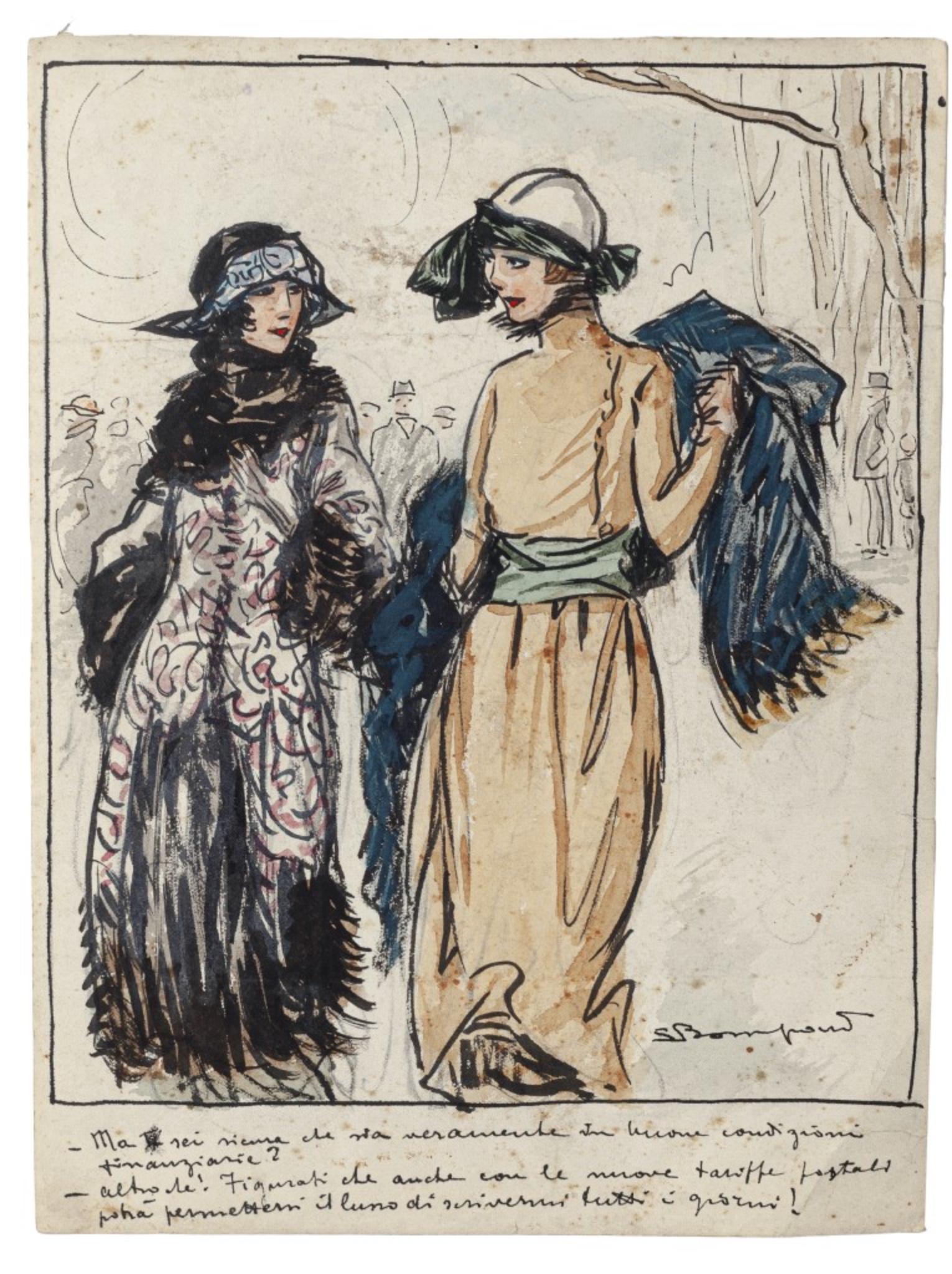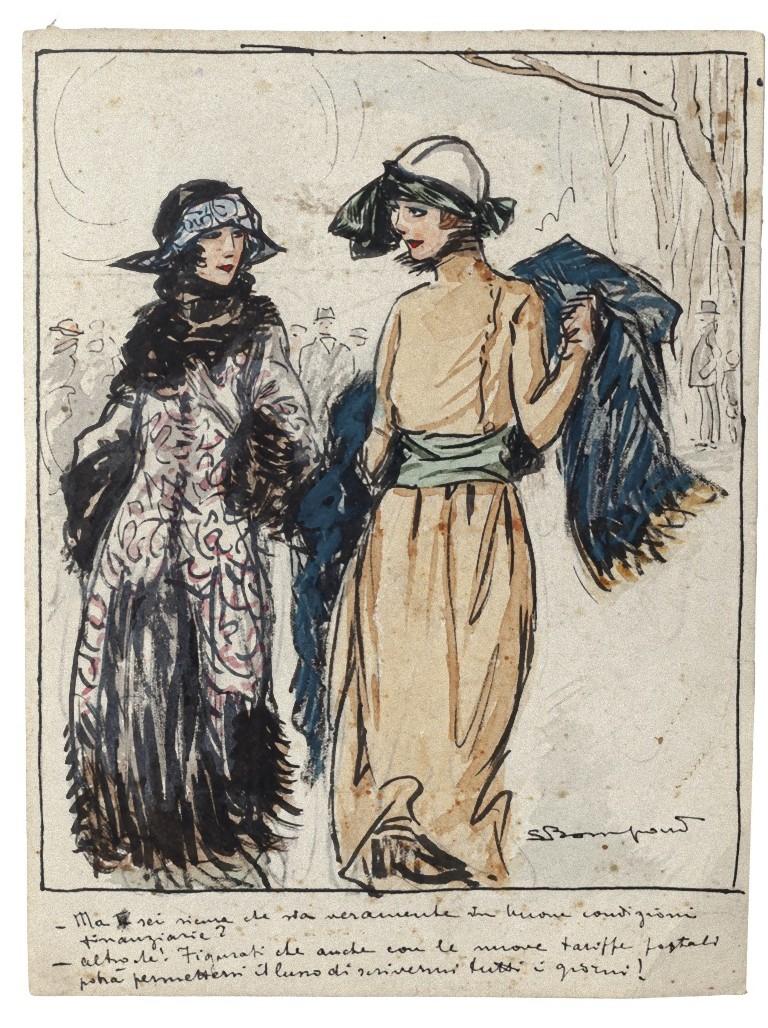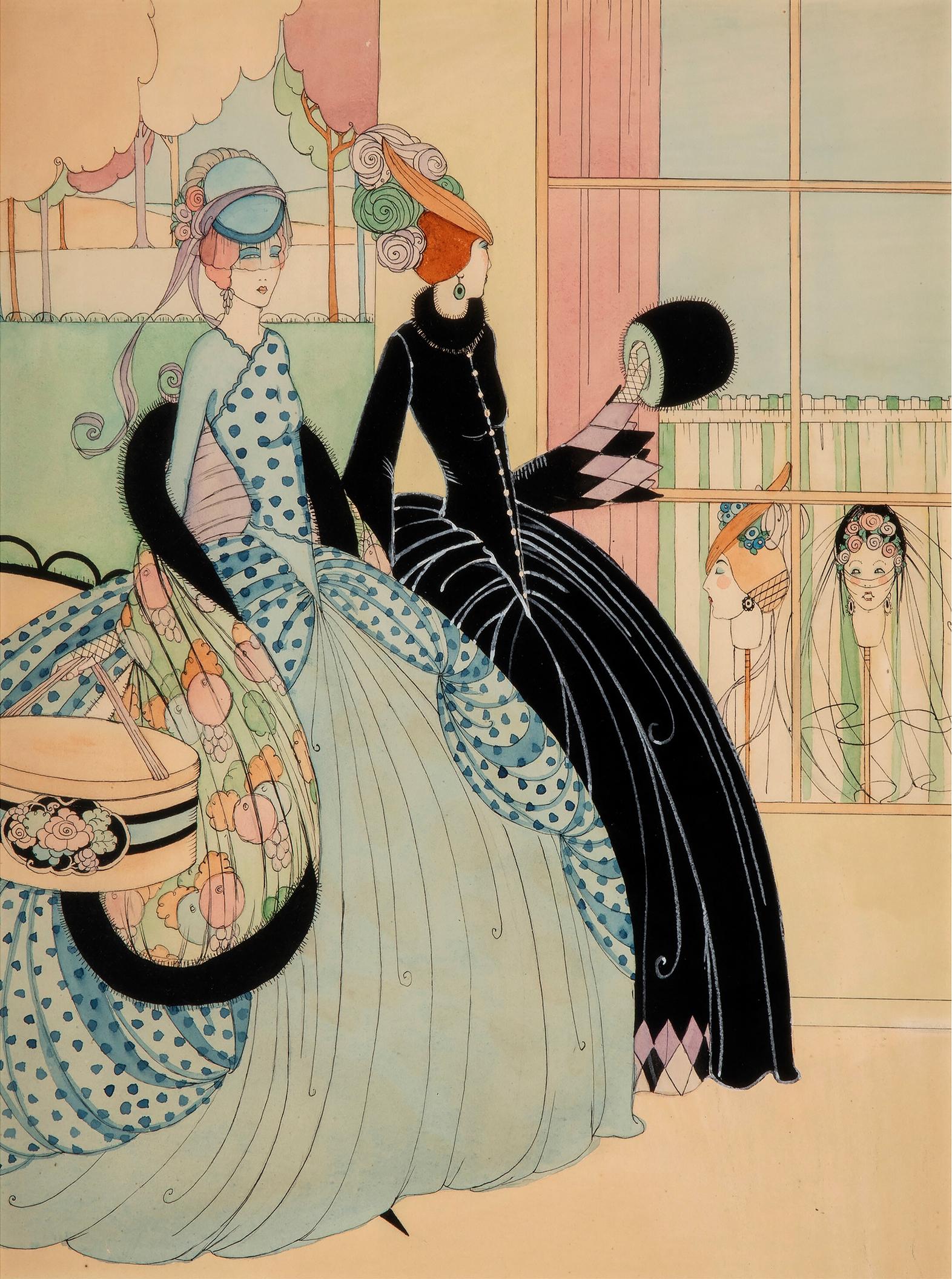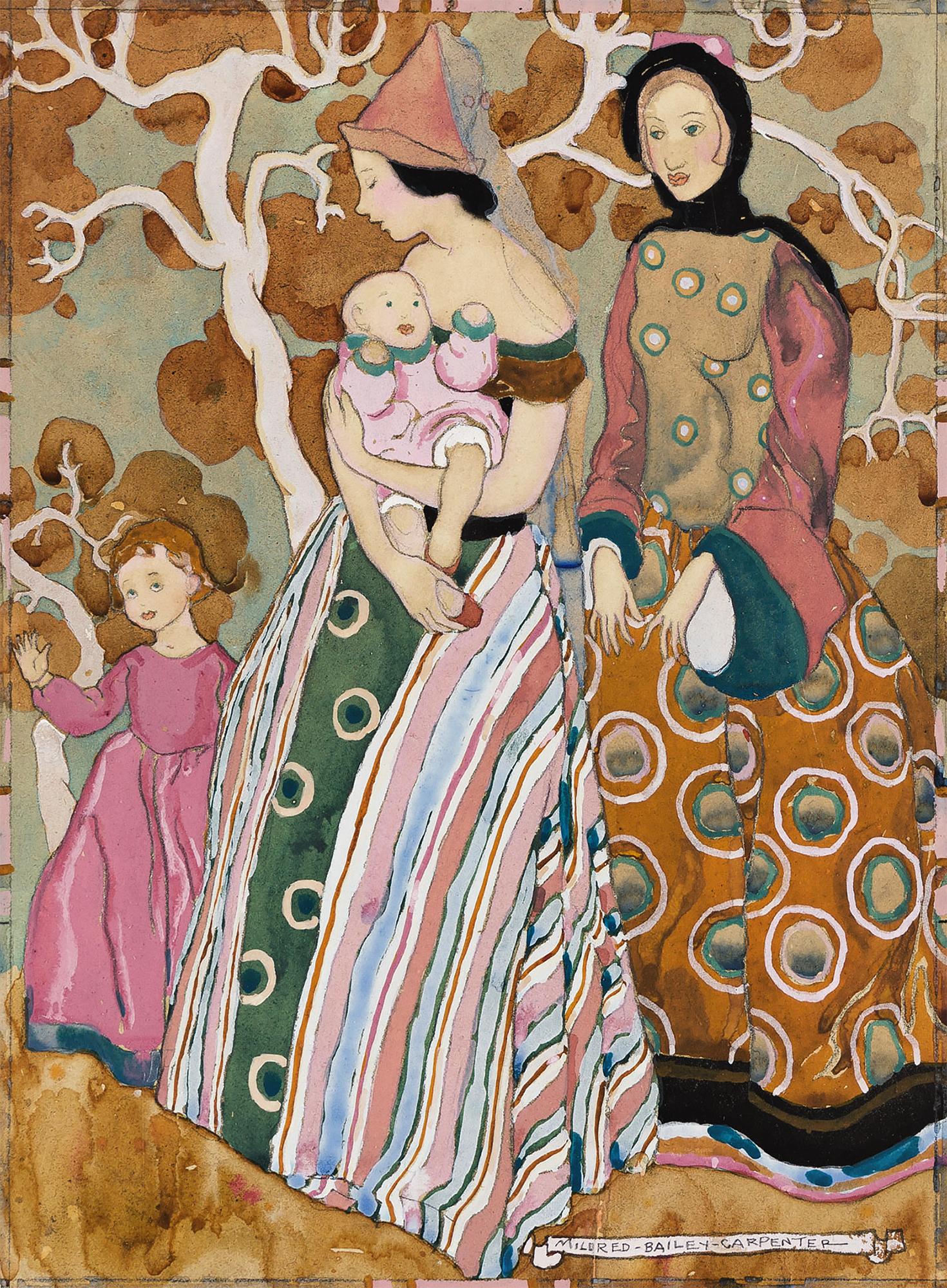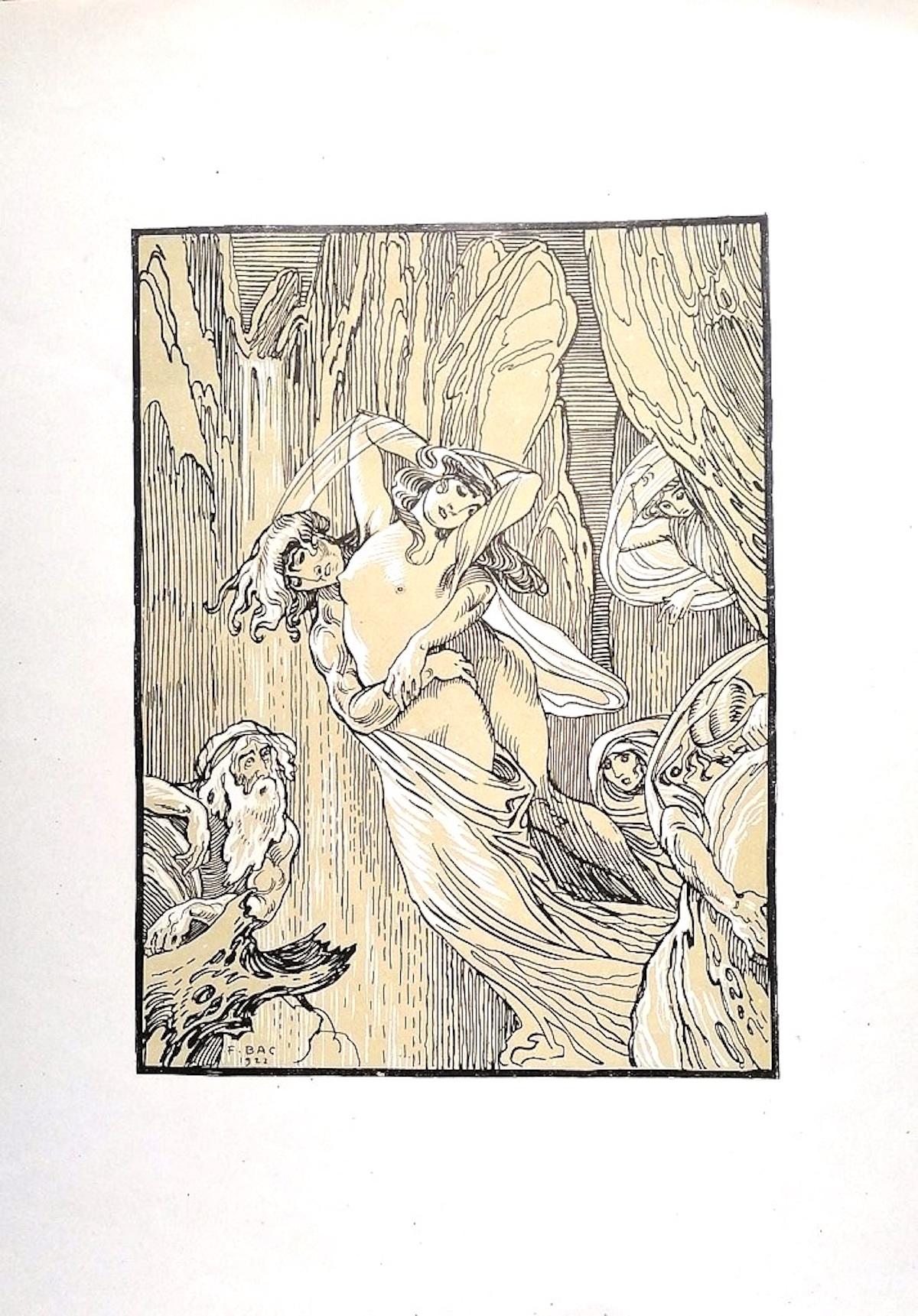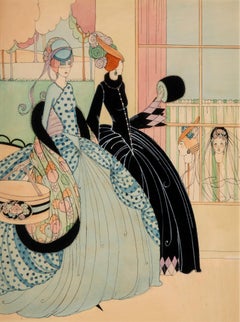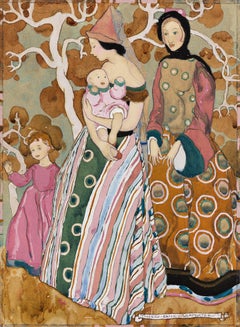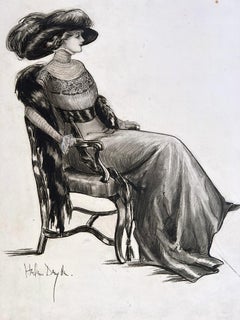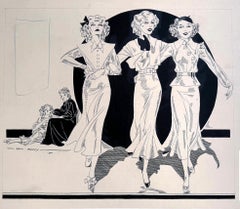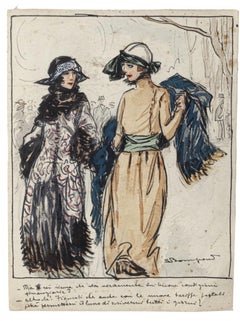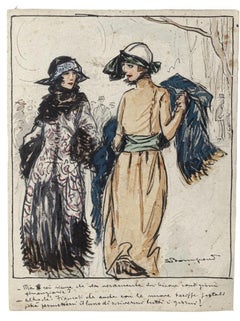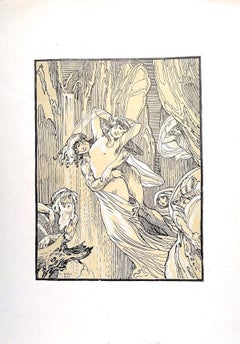Items Similar to The Court Ladies Dressed Gerda - Women Illustrators
Want more images or videos?
Request additional images or videos from the seller
1 of 12
Helen Jacobs BWSThe Court Ladies Dressed Gerda - Women Illustrators1936
1936
$2,800
£2,124.58
€2,429.26
CA$3,910.84
A$4,348.32
CHF 2,270.45
MX$52,929.68
NOK 28,970.01
SEK 27,143.51
DKK 18,130.03
Shipping
Retrieving quote...The 1stDibs Promise:
Authenticity Guarantee,
Money-Back Guarantee,
24-Hour Cancellation
About the Item
Women illustrators were alive, well, and quite active in the early 20th century. Most of their production was associated with topics that dealt with the home, children or fairy tales. In this masterfully rendered work in pen and ink, Jacobs displays great technical skill in presenting three maidens dressing a beautiful female member of the Court wearing a tiara. Signed in a cartouche lower right
From: Stella Mead, Great Stories from Many Lands, London: James Herbert and Co, 1936, page 78 " Red and White Roses"
Provenance: Chris Beetles
Work is elegantly matted and not framed.
Helen Mary Jacobs was born in Ilford, Essex, the sister of the writer W.W. Jacobs; she studied art at the West Ham Municipal College. She illustrated children’s books in pen, ink and watercolor. Towards the end of her career she specialized in drawings for educational books.
The artist first exhibited at the Royal Academy in 1910. She contributed to annuals such as Playbox, Rainbow and Little Folks, but very soon all the major publishers including Hodder & Stoughton, Ward Lock & SPCK, were commissioning her.
She also created a series of drawings of Moths for Lord Rothschild. From 1912 she had made enough to move to Winchmore Hill. She wanted to put back into the community - From Ask Art
- Creator:Helen Jacobs BWS (1888 - 1970, English)
- Creation Year:1936
- Dimensions:Height: 8.75 in (22.23 cm)Width: 13.25 in (33.66 cm)
- More Editions & Sizes:19.65 x 15 Price: $2,500
- Medium:
- Movement & Style:
- Period:
- Condition:Overall very good condition commensurate with age, pencil lines and overworked areas by the artist still evident on close inspection.
- Gallery Location:Miami, FL
- Reference Number:1stDibs: LU385312343792

About the Seller
4.9
Gold Seller
Premium sellers maintaining a 4.3+ rating and 24-hour response times
Established in 2005
1stDibs seller since 2016
115 sales on 1stDibs
Typical response time: 1 hour
- ShippingRetrieving quote...Shipping from: Miami, FL
- Return Policy
Authenticity Guarantee
In the unlikely event there’s an issue with an item’s authenticity, contact us within 1 year for a full refund. DetailsMoney-Back Guarantee
If your item is not as described, is damaged in transit, or does not arrive, contact us within 7 days for a full refund. Details24-Hour Cancellation
You have a 24-hour grace period in which to reconsider your purchase, with no questions asked.Vetted Professional Sellers
Our world-class sellers must adhere to strict standards for service and quality, maintaining the integrity of our listings.Price-Match Guarantee
If you find that a seller listed the same item for a lower price elsewhere, we’ll match it.Trusted Global Delivery
Our best-in-class carrier network provides specialized shipping options worldwide, including custom delivery.More From This Seller
View AllVogue - Elegantly Dressed Women Shopping For Hats Art Nouveau - Female Artist
By Helen Dryden
Located in Miami, FL
The present work by pioneering female artist Helen Dryden was most likely a cover assignment for Vogue Magazine. It is deftly rendered in a tight linear art nouveau style with flat c...
Category
1920s Figurative Drawings and Watercolors
Materials
Paper, Ink, Watercolor
Art Nouveau Illustration Women and Children in the Woods
Located in Miami, FL
Complex Art Nouveau patterns intertwined with gracefull figures define this work by American Artist and illustrator, teacher and lecturer Mildred Bailey Carpenter. Signed in cartouc...
Category
1920s Art Nouveau Figurative Drawings and Watercolors
Materials
Gouache, Paper, Board
Vogue Magazine Illustration Turn of the Century - Woman Illustrator
By Helen Dryden
Located in Miami, FL
Early in the artist's career most likely for Vogue Magazine. Signed lower left. Helen Dryden (1882–1972) was an American artist and successful industrial designer in the 1920s and 1...
Category
1910s Academic Figurative Drawings and Watercolors
Materials
India Ink, Pencil, Graphite, Gouache
The Three Graces Fantasy Fashion Illustration - Female Illustrator
Located in Miami, FL
For your consideration, we have a pen and ink drawing of an interpretation of The Three Graces, who strike a pose for a 1930s fashion ad. In Greek mythology, they were goddesses w...
Category
1930s American Impressionist Figurative Drawings and Watercolors
Materials
India Ink, Board
Flora Scottish Female Illustrator Glasgow Girls Pre-Raphaelites
Located in Miami, FL
Annie French was part of the Glasgow Girls group of artists and illustrators who worked in a delicate, feminine, and detailed Art Nouveau and Pre-Raphaelite style. This work, "Flora," is masterfully rendered and decorated with sumptuous floral patterns in the most detailed way. It is signed twice in the upper right quadrant. The mat has a hand-painted decorative border. The work presents better in person, and the viewer can marvel at the minute detail.
The Video is overexposed and light and not representative of color. Use still...
Category
Early 1900s Art Nouveau Figurative Drawings and Watercolors
Materials
Ink, Watercolor, Pencil
Female Illustrator, Flapper of 1800, Monochromatic
By Anna Whelan Betts
Located in Miami, FL
A "Flapper of 1800" is depicted in profile with her maid holding a hat box and cradling a little monkey. The maid is a step to the right and a step behind her. Overlapping garments v...
Category
1990s American Impressionist Figurative Paintings
Materials
Canvas, Oil, Board
You May Also Like
Two Women and a Knight - Original lithograph (1897/98)
By Robert Engels
Located in Paris, IDF
Robert ENGELS (1866 - 1926)
Two Women and a Knight
Original litograph
Printed signature in the plate
1897/98
Printed on paper Vélin
Size 40 x 31 cm (c. 16 x 12")
INFORMATION : P...
Category
1890s Art Nouveau Figurative Prints
Materials
Lithograph
Elegant Ladies - Watercolored Ink by Luigi Bompard - 20th Century
By Luigi Bompard
Located in Roma, IT
"Elegant Ladies" is an original watercolored ink drawing on ivory-colored paper, signed by Luigi Bompard (1879-1953).
In excellent conditions: as good...
Category
Early 20th Century Modern Figurative Drawings and Watercolors
Materials
Watercolor, Ink
Elegant Ladies - Watercolor and Ink by Luigi Bompard - 1920s
Located in Roma, IT
"Elegant Ladies" is an original watercolored ink drawing on ivory-colored paper, realized by Luigi Bompard (1879-1953) in 1920s.
Hand-signed in pen o...
Category
1920s Art Deco Figurative Drawings and Watercolors
Materials
Ink, Watercolor
$539 Sale Price
25% Off
The Crying Women - Original Lithograph by Ferdinand Bac - 1922
Located in Roma, IT
The Falling Woman is an original modern artwork realized by Ferdinand Bac (1859 - 1952) in 1922.
Signed and dated on plate on the lower left corner: F. ...
Category
1920s Art Nouveau Figurative Prints
Materials
Lithograph
Caerulea - British Art Deco c1935 watercolour and ink figurative painting
Located in London, GB
This beautiful British Art Deco 1930's water colour and ink painting on paper is by well respected artist Averil Mary Burleigh. Painted circa 1935 the composition is of three female figures with flowing robes and head dresses with slender tree trunks beyond them and vivid blue of the sky meeting the sea. (Caerula pertains to the colour of the sky and sea). They are playing between them with two balls or globes. A beautiful painting full of fun and movement and that amazing blue.
Signed lower left, and inscribed on a label verso.
Provenance: Surrey estate.
Condition. Water colour and ink on paper. Image size is 24 inches by 16 inches and in excellent condition.
Frame. Housed in a gilt frame. Framed size is 30 inches by 22 inches and in good condition.
Averil Mary Burleigh born Averil Mary Dell (1883 – 1949) was a British artist and painter. Based in Sussex, Burleigh was known for painting in egg tempera with the subject usually involving a central figure. Her husband and daughter also painted but she is the best regarded of the three. Burleigh was born in 1883 in Hassocks in West Sussex and went on to study at the Brighton School of Art. She married the painter Charles Burleigh and they lived and worked together as artists in Hove and Sussex. They designed a house with a large sun-lit top floor studio. Their daughter Veronica, who would also become a notable artist, was born there in 1909. The family never became rich from their works, and often relied on Burleigh's flair for buying and selling shares. In 1911 Burleigh illustrated a book of John Keats' poetry and went on to illustrate plays by Shakespeare. In 1913 she was featured in Studio magazine. In 1927 Burleigh illustrated Thistledown by Leolyn Louise Everett. From 1939 she was a member of the Royal Society of Painters in Watercolours. Burleigh became very ill in the 1940s, dying in 1949. Shortly before she died, Burleigh was elected an associate of the Royal Watercolour Society. Burleigh specialised in tempera painting, although she also worked in chalk and watercolour. Her works tend to have a bright colour palette with contrasting colours to lead the eye around the picture. A sharp luminosity and strong sense of design govern Burleigh's tempera and watercolour paintings. Frequently, her works portray decorative renaissance subjects, usually dominated by a female figure who is regularly modelled on her daughter, Veronica Burleigh...
Category
1930s Art Deco Figurative Drawings and Watercolors
Materials
Ink, Watercolor
Averil BurleighCaerulea - British Art Deco c1935 watercolour and ink figurative painting, Circa 1935
$13,163 Sale Price
20% Off
Portrait de Mme De Mornand - Ink on Paper by Maurice Lourdey - 1910
Located in Roma, IT
Portrait de Mme de Mornand is an original drawing in ink on paper realized by Maurice Lourdey (1860-1934)
Dated on the upper right 22.02.10
Stamp on the lower right ""CJ"
Good con...
Category
1910s Art Nouveau Figurative Drawings and Watercolors
Materials
Ink
